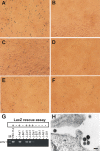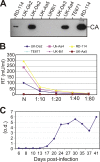Isolation of an infectious endogenous retrovirus in a proportion of live attenuated vaccines for pets
- PMID: 20106919
- PMCID: PMC2838105
- DOI: 10.1128/JVI.02715-09
Isolation of an infectious endogenous retrovirus in a proportion of live attenuated vaccines for pets
Abstract
The genomes of all animal species are colonized by endogenous retroviruses (ERVs). Although most ERVs have accumulated defects that render them incapable of replication, fully infectious ERVs have been identified in various mammals. In this study, we isolated a feline infectious ERV (RD-114) in a proportion of live attenuated vaccines for pets. Isolation of RD-114 was made in two independent laboratories using different detection strategies and using vaccines for both cats and dogs commercially available in Japan or the United Kingdom. This study shows that the methods currently employed to screen veterinary vaccines for retroviruses should be reevaluated.
Figures


Similar articles
-
Contamination of live attenuated vaccines with an infectious feline endogenous retrovirus (RD-114 virus).Arch Virol. 2014 Mar;159(3):399-404. doi: 10.1007/s00705-013-1809-1. Epub 2013 Sep 26. Arch Virol. 2014. PMID: 24068581 Free PMC article. Review.
-
Endogenous retroviruses as potential hazards for vaccines.Biologicals. 2010 May;38(3):371-6. doi: 10.1016/j.biologicals.2010.03.003. Epub 2010 Apr 8. Biologicals. 2010. PMID: 20378372 Review.
-
Infectious endogenous retroviruses in cats and emergence of recombinant viruses.J Virol. 2012 Aug;86(16):8634-44. doi: 10.1128/JVI.00280-12. Epub 2012 Jun 6. J Virol. 2012. PMID: 22674983 Free PMC article.
-
Tracking the Fate of Endogenous Retrovirus Segregation in Wild and Domestic Cats.J Virol. 2019 Nov 26;93(24):e01324-19. doi: 10.1128/JVI.01324-19. Print 2019 Dec 15. J Virol. 2019. PMID: 31534037 Free PMC article.
-
Existence of Two Distinct Infectious Endogenous Retroviruses in Domestic Cats and Their Different Strategies for Adaptation to Transcriptional Regulation.J Virol. 2016 Sep 29;90(20):9029-45. doi: 10.1128/JVI.00716-16. Print 2016 Oct 15. J Virol. 2016. PMID: 27466428 Free PMC article.
Cited by
-
Extraneous agent detection in vaccines--a review of technical aspects.Biologicals. 2012 Jul;40(4):225-30. doi: 10.1016/j.biologicals.2012.04.004. Epub 2012 May 9. Biologicals. 2012. PMID: 22575785 Free PMC article. Review.
-
Contamination of live attenuated vaccines with an infectious feline endogenous retrovirus (RD-114 virus).Arch Virol. 2014 Mar;159(3):399-404. doi: 10.1007/s00705-013-1809-1. Epub 2013 Sep 26. Arch Virol. 2014. PMID: 24068581 Free PMC article. Review.
-
Experimental infection of dogs with a feline endogenous retrovirus RD-114.Acta Vet Scand. 2011 Jan 27;53(1):3. doi: 10.1186/1751-0147-53-3. Acta Vet Scand. 2011. PMID: 21269522 Free PMC article.
-
Of Mice and Men: On the Origin of XMRV.Front Microbiol. 2011 Jan 17;1:147. doi: 10.3389/fmicb.2010.00147. eCollection 2010. Front Microbiol. 2011. PMID: 21687768 Free PMC article.
-
Cloning and characterization of the antiviral activity of feline Tetherin/BST-2.PLoS One. 2011 Mar 29;6(3):e18247. doi: 10.1371/journal.pone.0018247. PLoS One. 2011. PMID: 21479233 Free PMC article.
References
-
- Arnaud, F., M. Caporale, M. Varela, R. Biek, B. Chessa, A. Alberti, M. Golder, M. Mura, Y.-P. Zhang, L. Yu, F. Pereira, J. C. DeMartini, K. Leymaster, T. E. Spencer, and M. Palmarini. 2007. A paradigm for virus-host coevolution: sequential counter-adaptations between endogenous and exogenous retroviruses. PLoS Pathog. 3:e170. - PMC - PubMed
-
- Boeke, J. D., and J. P. Stoye. 1997. Retrotransposons, endogenous retroviruses and the evolution of retroelements, p. 343-436. In J. M. Coffin, S. H. Hughes, and H. E. Varmus (ed.), Retroviruses. Cold Spring Harbor Laboratory Press, Plainview, NY. - PubMed
Publication types
MeSH terms
Substances
Grants and funding
LinkOut - more resources
Full Text Sources
Medical
Miscellaneous

